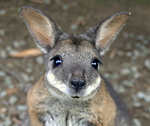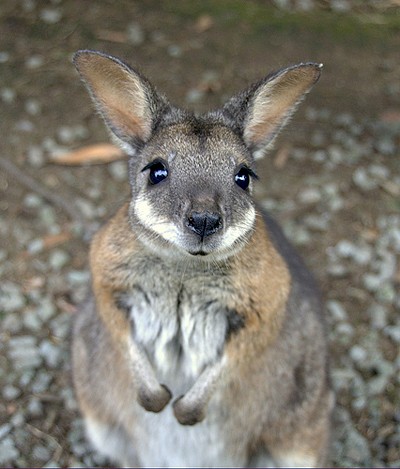Mow your grass with a wallaby
Wallabies are pets with a difference – they’ve turned out to be fantastic lawnmowers


Many a walker in the Peak District has been startled by a wallaby springing across their path, living wild and apparently very much at home thousands of miles from its native Australia. Now, however, these attractive marsupials have become the latest must-have ‘pet’. In the past five years, UK wallaby breeders have reported a steady rise in demand, mainly from people wanting an unusual animal to help to keep the lawn trim and be a talking point.
‘The interest in them this year has been absolutely crazy,’ says Quintin Spratt, 60, a south Norfolk farmer who diversified into breeding exotic animals 20 years ago. Mr Spratt, who specialises in peacocks and has just supplied two white peafowl to the set of the latest Harry Potter film, adds: ‘The wallabies particularly albinos are just a sideline for us, but with all this publicity, I’ve sold all the wallabies I’ve bred this year.’
Wallabies cost £150 for a male and £600 to £700 for a female; the sought-after albinos can fetch £500 and £1,000 respectively. They’re always sold in at least a pair, as they’re group animals. And breeders are, rightly, fussy about whom they sell to because wallabies require at least half an acre of land surrounded by a 5ft-high fence. ‘They’re pretty little animals and children love them, especially when they’re carrying a little joey in their pouch,’ says Mr Spratt. ‘They can’t be kept as pets, however. They’re very shy, so it’s not as if you can stroke them.’

Viscount Bledisloe remembers wallabies in the park of his family home, Lydney Park in Gloucestershire, during the 1970s. His grandfather had bought two pairs from Sir Giles Loder at Leonardslee. ‘I recall the wallabies being good fun and very tame. They would suddenly bounce out of the bracken across the path right in front of us. They survived for a few years and bred I think we had about eight at one time but our deer-park wall was less secure then and, gradually, they all jumped out.’
Most wild wallabies are in this country thanks to Capt Courtney Brocklehurst, a Staffordshire landowner, who was killed in the Second World War. After his death, war regulations decreed the disposal of his private zoo at Roaches House, near Buxton, and five red-necked wallabies were released into the countryside. By the 1960s, numbers had risen to 50. And, although sightings are still reported today, numbers have dwindled due to road kills, dogs, foxes and disturbance.
There are feral wallabies in the s the originals escaped from a zoo and a colony on the island of Inchconnachan in Loch Lomond, Scotland, which was introduced in the 1920s. Wild wallabies have been spotted near Teignmouth, Devon, in the Ashdown Forest, East Sussex, and on Bute and Lundy.
Just as Canadians wonder why some Britons want beavers, many conservationists are less enamoured with this latest ‘non-native species’ breeding success. ‘Wallabies have no place in the English countryside,’ points out Dr Stephen Tapper of the Game & Wildlife Conservation Trust. ‘They should be confined to zoos and wildlife parks. As natives of the Southern Hemisphere, they are even more alien than other species that have got here by accident or design from Europe and North America.’
Exquisite houses, the beauty of Nature, and how to get the most from your life, straight to your inbox.
An experienced journalist, Paula Minchin, Country Life's Managing & Features Editor, has worked for the magazine for 10 years — during which time she’s overseen two special issues guest-edited by His Majesty The King in 2013 and in 2018, and the bestselling 2022 edition masterminded by his wife, Queen Camilla. A gamekeeper’s daughter, Paula began her career as a crime reporter on The Sidmouth Herald in Devon, before becoming Pony Club & Young Rider Editor, then Racing Editor, at Horse & Hound. Paula lives in Somerset with her two working Labradors, Nimrod and Rocky.
